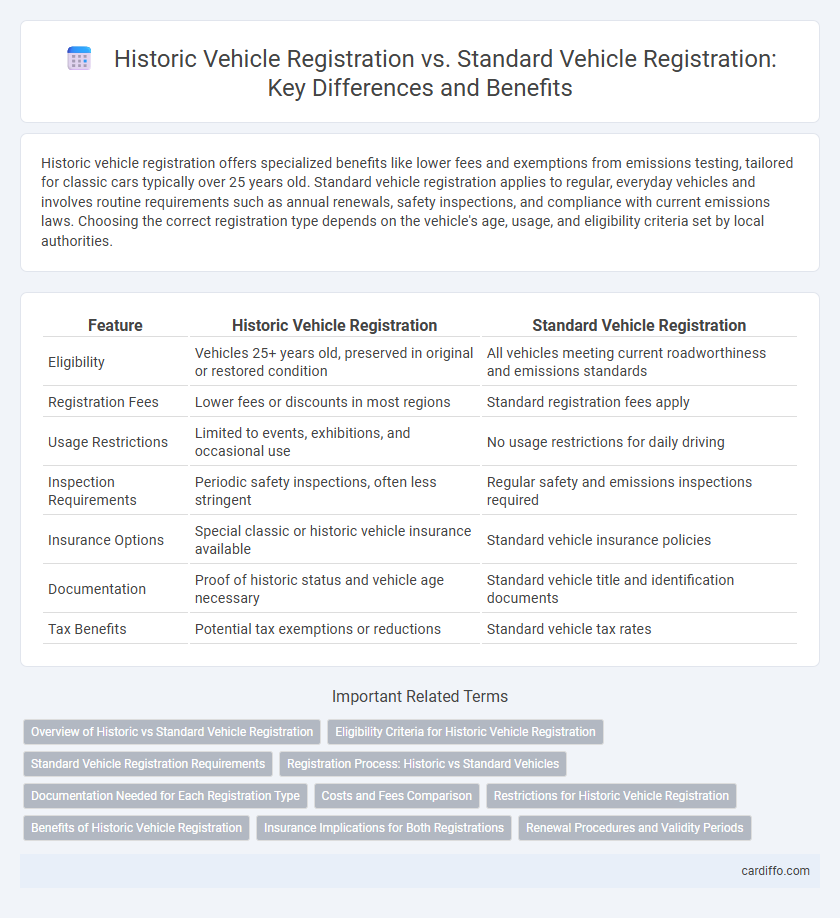Historic vehicle registration offers specialized benefits like lower fees and exemptions from emissions testing, tailored for classic cars typically over 25 years old. Standard vehicle registration applies to regular, everyday vehicles and involves routine requirements such as annual renewals, safety inspections, and compliance with current emissions laws. Choosing the correct registration type depends on the vehicle's age, usage, and eligibility criteria set by local authorities.
Table of Comparison
| Feature | Historic Vehicle Registration | Standard Vehicle Registration |
|---|---|---|
| Eligibility | Vehicles 25+ years old, preserved in original or restored condition | All vehicles meeting current roadworthiness and emissions standards |
| Registration Fees | Lower fees or discounts in most regions | Standard registration fees apply |
| Usage Restrictions | Limited to events, exhibitions, and occasional use | No usage restrictions for daily driving |
| Inspection Requirements | Periodic safety inspections, often less stringent | Regular safety and emissions inspections required |
| Insurance Options | Special classic or historic vehicle insurance available | Standard vehicle insurance policies |
| Documentation | Proof of historic status and vehicle age necessary | Standard vehicle title and identification documents |
| Tax Benefits | Potential tax exemptions or reductions | Standard vehicle tax rates |
Overview of Historic vs Standard Vehicle Registration
Historic vehicle registration applies to vehicles typically over 25 years old, offering exemptions from emissions testing and reduced registration fees, designed to preserve automotive heritage. Standard vehicle registration covers all modern vehicles and requires compliance with current safety and emissions standards, with regular fee structures. Both types require proof of ownership and valid insurance, but historic registration often entails usage restrictions limiting the vehicle mainly to exhibitions and occasional driving.
Eligibility Criteria for Historic Vehicle Registration
Historic Vehicle Registration eligibility requires the vehicle to be at least 25 years old or classified as a classic by the manufacturer, emphasizing preservation of vehicles with historical or cultural significance. Unlike standard vehicle registration, applicants must provide documentation proving the vehicle's authenticity, age, and original condition to qualify for historic status. Restrictions may include limited use for exhibitions, parades, or maintenance, distinguishing it from the unrestricted use permitted under standard registration.
Standard Vehicle Registration Requirements
Standard vehicle registration requires proof of ownership, a completed application form, and payment of registration fees. Applicants must provide a valid government-issued ID, current vehicle insurance, and pass a safety and emissions inspection if applicable. Registration documents typically include the vehicle title, proof of address, and sometimes a vehicle identification number (VIN) verification.
Registration Process: Historic vs Standard Vehicles
Historic vehicle registration requires providing proof of the vehicle's age, typically over 25 years, and may involve submitting documentation demonstrating its collector or classic status, whereas standard vehicle registration primarily focuses on current ownership, insurance, and compliance with emission standards. The registration process for historic vehicles often includes inspections specific to safety and originality to preserve authenticity, while standard vehicle registration emphasizes routine safety and emissions inspections. Processing times for historic vehicle registration can be longer due to the additional verification steps compared to the typically faster standard vehicle registration process.
Documentation Needed for Each Registration Type
Historic vehicle registration requires proof of the vehicle's age, such as a manufacturer's certificate of origin or vehicle title indicating it is over a specific age, typically 25 years or older, along with a completed application for historic plates. Standard vehicle registration demands current ownership documentation, including a valid title, bill of sale, and proof of insurance, plus passing emissions and safety inspections if applicable. Both registration types require valid identification and payment of registration fees, but historic registration often exempts vehicles from emissions testing and certain taxes.
Costs and Fees Comparison
Historic vehicle registration typically involves lower fees compared to standard vehicle registration due to reduced taxation and insurance costs tailored for classic cars. Standard vehicle registration fees are generally higher and calculated based on factors like vehicle age, weight, and market value, reflecting broader usage and environmental considerations. Owners must consider that historic vehicle registration may include specific eligibility criteria and usage restrictions that can affect overall cost-effectiveness.
Restrictions for Historic Vehicle Registration
Historic Vehicle Registration imposes restrictions such as limitations on annual mileage, typically capping usage between 2,500 to 5,000 miles per year to preserve vehicle condition. Owners must comply with stringent maintenance and originality standards, ensuring that modifications are minimal and consistent with the vehicle's restoration period. Unlike standard vehicle registration, historic registration often prohibits commercial use and daily commuting to maintain the vehicle's status as a collectible or show car.
Benefits of Historic Vehicle Registration
Historic Vehicle Registration offers significant benefits such as reduced registration fees and exemption from certain emissions testing requirements, making it cost-effective for owners of classic cars. It provides legal recognition for vehicles that are at least 25 years old, preserving automotive heritage while allowing limited, non-commercial use. Owners also gain access to specialized license plates and potential insurance discounts, enhancing both the vehicle's value and owner's savings.
Insurance Implications for Both Registrations
Historic vehicle registration often requires specialized insurance policies that typically offer lower premiums due to limited usage and restricted mileage, reflecting the vehicle's vintage status. Standard vehicle registration mandates comprehensive insurance coverage with higher premiums based on regular usage, mandatory liability limits, and risk factors such as mileage and driver history. Understanding these insurance implications is crucial for vehicle owners to ensure compliance with legal requirements and to optimize cost-efficiency based on their registration type.
Renewal Procedures and Validity Periods
Historic vehicle registration typically requires renewal every 1 to 3 years depending on the jurisdiction, with specific documentation proving the vehicle's age and historical significance. Standard vehicle registration mandates annual renewal, often involving updated insurance proof and emission tests, ensuring compliance with current safety and environmental standards. Validity periods for historic registrations are generally longer or more flexible to accommodate preservation efforts, whereas standard registrations adhere to strict yearly cycles for regulatory control.
Historic Vehicle Registration vs Standard Vehicle Registration Infographic

 cardiffo.com
cardiffo.com